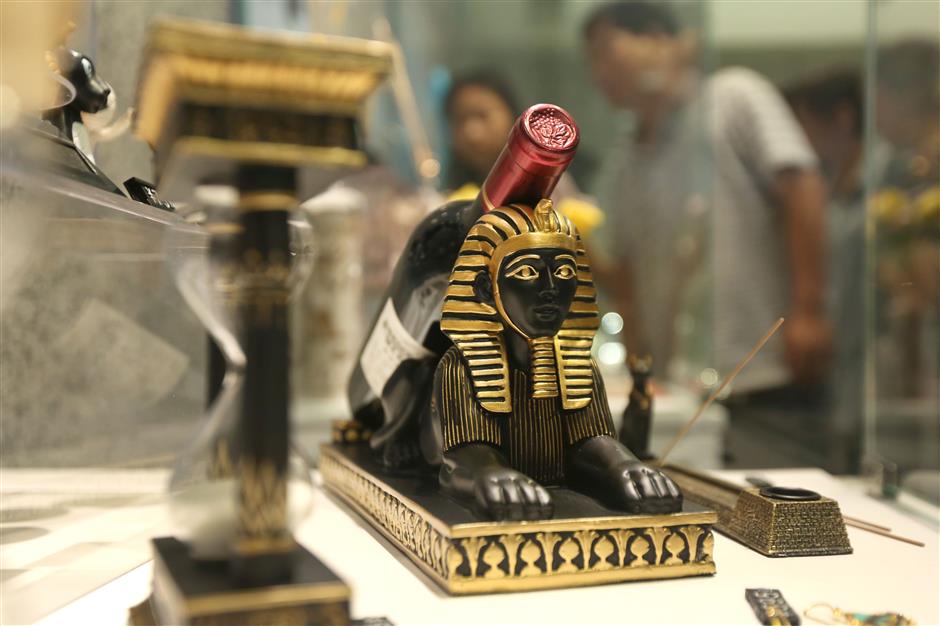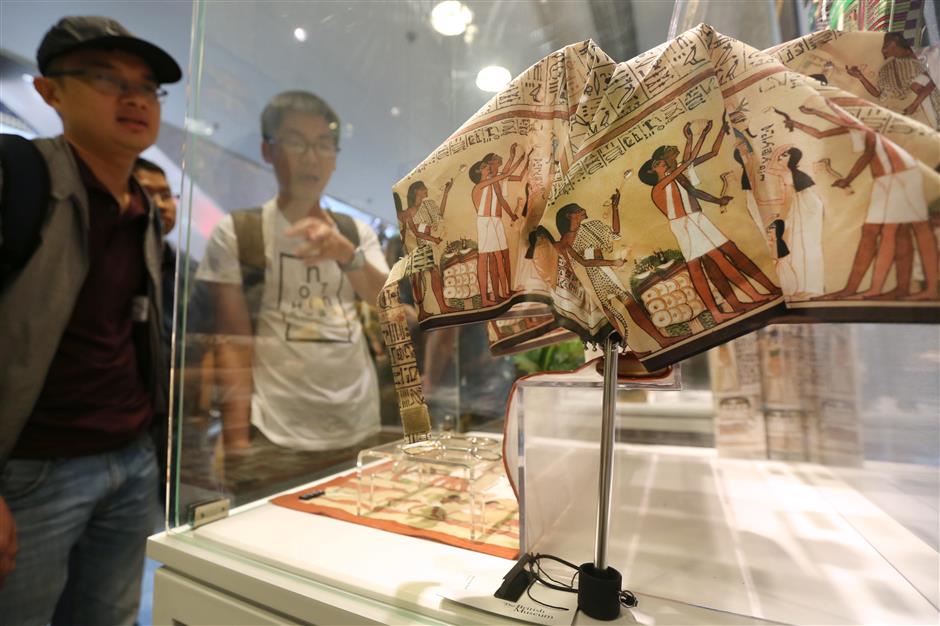A taste of art and history ─ in a hurry

The Sphinx-shaped wine rack
“Have you visited ‘A History of the World in 100 Objects from the British Museum’?” This has probably been the most-asked question for the past weeks among local art lovers.
The exhibition has so far attracted more than 110,000 visitors since it opened at the Shanghai Museum at the end of June. Even now in the scorching heat, people still need to line up for at least three hours to get into the exhibition.
Inspired by the highly acclaimed 2010 radio series and book, which was produced in partnership with the BBC and Penguin Books, this exhibition tells one version of an extraordinary story — the history of the world.
Using 100 key objects from the British Museum’s encyclopedic collection, the exhibition highlights remarkable stories revealed through the most humble of objects, such as a tiny stone seal that led to the rediscovery of a lost civilization, and fragments of pottery discarded on a beach in Africa that point to the vast distances travelled by early traders across the Indian Ocean.
The exhibition is so popular that the Shanghai Museum was forced to limit the number of visitors to 8,000 at a time.
The long queue outside the entrance at stretches all the way to the museum’s third floor may put many art lovers off.
But there is something else for those who don’t have the patience or time to wait outside for hours under the scorching sun but who want a taste of – souvenirs.
Li Feng, deputy director of Shanghai Museum, says there are more than 160 souvenirs designed directly from the British Museum, the Metropolitan Museum in the United States, Museumsinsel in Berlin and the Shanghai Museum that are available at the local museum, varying from biscuits, jewelry to stationery and toy figures.
About 50 products are developed by the Shanghai Museum.
But what he didn’t expect was that many of them would sell out on the first day of the exhibition.
Xu Jiahe, a 41-year-old white-collar worker, says that she bought two jewelry boxes on the first day. “I was immediately drawn by them at first sight.”
The toy figure in the shape of Bastet -— an ancient Egyptian goddess — is even priced for 4,000 yuan (US$600) online. It originally cost 150 yuan.
“We didn’t expect the art derivatives to be so popular,” Li says. “So we immediately asked our suppliers for more.”
Li says this is the biggest scale of art derivatives for an exhibition in the museum’s history. The best sellers are biscuits, chocolates and toy figures. The first two sell for about 30 yuan a packet.
Hu Jingwen, a visitor from Beijing, thinks a packet of three chocolates at 28 yuan is a perfect gift.
“I bought about five packets, and I am sure my friends will like them,” she says.

A silk scarf featuring ancient Egyptian characters
Hu Xuwen, general manager of the museum’s art product company, says turnover from June 28 to July 16 alone was 3 million yuan.
“Even English experts from the British Museum bought many of the souvenirs before they went back.”
Now the cafeteria on the second floor is the museum's “second destination choice.”
A cup of latte with foam in the shape of “Bastet,” accompanied with chocolates or biscuits made in the shape of ancient Egyptian characters or symbols, can be a perfect way to relax.
“Edible art derivatives is perhaps a new trend,” says Hu.
“During the summer vacation, many parents brought their children to the exhibition. But the long history of ancient Egypt is a bit hard for children to understand. So how to impress our little visitors? Through these things like coffee and snacks, they might start to get an understanding of the image of the Goddess Isis, or the Bastet. They would know that visiting an exhibition is not boring but interesting,” she explains.
For Hu, price usually determines popularity.
“Our past experiences tells us that those products priced from 50 yuan to 100 yuan are the bestsellers,” Hu says. “We want to develop the art derivatives that one can wear, use or eat.”
Christine Liu, a 28-year-old marketing assistant, says: “I am a gift shop lover. Those small things remind me of where I visited and some marvelous works that I saw at different museums, such as a refrigerator magnet featuring Monet’s ‘Sunset’ I bought from the British Museum last summer."
In 1985 when it opened, the small shop in the Shanghai Museum just sold copies of antiques. But since 1996, the museum has developed original designs and now has boutique stores in Xintiandi, Oriental Pearl TV Tower, Pudong International Airport, as well as online.
“We have nearly 10,000 art derivatives,” Hu says.
The average age of the design team is around 40.
“Our team is not young because our designers need to have a profound knowledge of the antiques,” Hu says. “The longer they stay at the museum, the deeper they understand them. But still the products we design need to appeal to all visitors, and ‘A History of the World’ is a golden opportunity for us to develop new ideas.”

Various ancient Egypt-themed accessories















